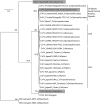Isolation of a novel species of flavivirus and a new strain of Culex flavivirus (Flaviviridae) from a natural mosquito population in Uganda
- PMID: 19656970
- PMCID: PMC2885038
- DOI: 10.1099/vir.0.014183-0
Isolation of a novel species of flavivirus and a new strain of Culex flavivirus (Flaviviridae) from a natural mosquito population in Uganda
Abstract
The genus Flavivirus, which contains approximately 70 single-stranded, positive-sense RNA viruses, represents a unique model for studying the evolution of vector-borne disease, as it includes viruses that are mosquito-borne, tick-borne or have no known vector. Both theoretical work and field studies suggest the existence of a large number of undiscovered flaviviruses. Recently, the first isolation of cell fusing agent virus (CFAV) was reported from a natural mosquito population in Puerto Rico, and sequences related to CFAV have been discovered in mosquitoes from Thailand. CFAV had previously been isolated from a mosquito cell line in 1975 and represented the only known 'insect-only' flavivirus, appearing to replicate in insect cells alone. A second member of the 'insect-only' group, Kamiti River virus (KRV), was isolated from Kenyan mosquitoes in 2003. A third tentative member of the 'insect-only' group, Culex flavivirus (CxFV), was first isolated in 2007 from Japan and further strains have subsequently been reported from the Americas. We report the discovery, isolation and characterization of two novel 'insect-only' flaviviruses from Entebbe, Uganda: a novel lineage tentatively designated Nakiwogo virus (NAKV) and a new strain of CxFV. The individual mosquitoes from which these strains were isolated, identified retrospectively by using a reference molecular phylogeny generated using voucher specimens from the region, were Mansonia africana nigerrima and Culex quinquefasciatus, respectively. This represents the first isolation, to our knowledge, of a novel insect-only flavivirus from a Mansonia species and the first isolation of a strain of CxFV from Africa.
Figures






References
-
- Baqar, S., Hayes, C. G., Murphy, J. R. & Watts, D. M. (1993). Vertical transmission of West Nile virus by Culex and Aedes species mosquitoes. Am J Trop Med Hyg 48, 757–762. - PubMed
-
- Cammisa-Parks, H., Cisar, L. A., Kane, A. & Stollar, V. (1992). The complete nucleotide sequence of cell fusing agent (CFA): homology between the nonstructural proteins encoded by CFA and the nonstructural proteins encoded by arthropod-borne flaviviruses. Virology 189, 511–524. - PubMed
-
- Cook, S., Bennett, S. N., Holmes, E. C., De Chesse, R., Moureau, G. & de Lamballerie, X. (2006). Isolation of a new strain of the flavivirus cell fusing agent virus in a natural mosquito population from Puerto Rico. J Gen Virol 87, 735–748. - PubMed
-
- Crabtree, M. B., Sang, R. C., Stollar, V., Dunster, L. M. & Miller, B. R. (2003). Genetic and phenotypic characterization of the newly described insect flavivirus, Kamiti River virus. Arch Virol 148, 1095–1118. - PubMed
-
- Crochu, S., Cook, S., Attoui, H., Charrel, R., De Cheese, R., Belhouchet, M., Lemasson, J.-J., de Micco, P. & de Lamballarie, X. (2004). Sequence of flavivirus-related RNA viruses persist in DNA form in the genome of Aedes spp. mosquitoes. J Gen Virol 85, 1971–1980. - PubMed
Publication types
MeSH terms
Substances
Associated data
- Actions
- Actions
- Actions
- Actions
- Actions
- Actions
- Actions
- Actions
- Actions
- Actions
- Actions
- Actions
- Actions
- Actions
- Actions
- Actions
- Actions
- Actions
- Actions
- Actions
- Actions
- Actions
- Actions
- Actions
- Actions
- Actions
- Actions
- Actions
- Actions
- Actions
- Actions
- Actions
- Actions
- Actions
- Actions
- Actions
- Actions
- Actions
- Actions
- Actions
- Actions
- Actions
- Actions
- Actions
- Actions
- Actions
- Actions
- Actions
- Actions
- Actions
- Actions
- Actions
Grants and funding
LinkOut - more resources
Full Text Sources

